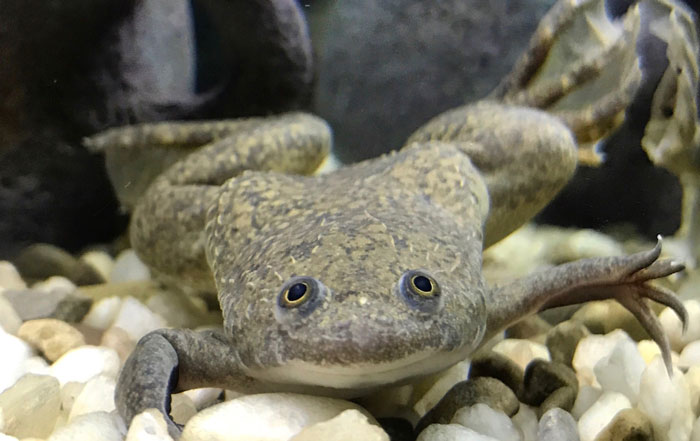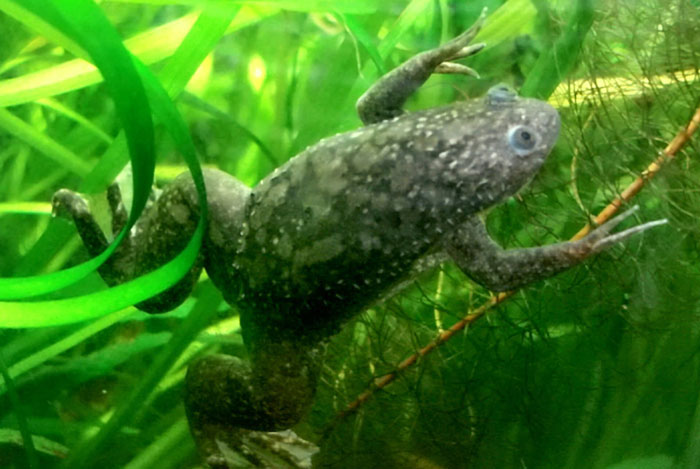frogs can’t grow back their legs like some other animals can. They can heal small cuts and injuries, but if they lose a whole leg, they can’t make a new one.
When frogs are just tadpoles, they have a neat trick up their sleeves. They can regrow their lost limbs. Once they become adult frogs, they lose this ability.
So, let’s dive into the pond and gather some interesting facts about frogs’ regrow limbs–
Can Frogs Regrow Lost Limbs Naturally?
No, frogs can’t naturally grow back lost limbs like some other animals can, such as salamanders. But smart scientists have figured out ways to help frogs grow back their limbs in experiments.

This is a big step forward in science, and it shows that in the future, we might be able to do even more amazing things with regrowing body parts!
How Did Scientists Help Frogs Regrow Limbs?
Scientists at Tufts and Harvard University have made a big step in limb regrowth. They put a mix of medicines and placed it over the part where the frog’s leg was missing.
They left it there for only one day. After this, something amazing happened! For the next year and a half, the frog’s leg started growing back.

This is a big deal because frogs normally can’t do this. The new legs worked almost like normal ones. They can move and feel. The treatment involved a gel with five drugs. That is put on the amputated area. This started a long process of regrowth.
A special cap, called the BioDome, is put on the first day after the injury. It creates a safe space, kind of like a protective bubble, just like how a baby grows inside a mom.
Each drug did something important, like reducing swelling and helping nerves and muscles grow. And the result is the regrowth instead of just closing the wound.
The Newly Developed Limbs:
The new limbs had bones and tissues, even little “toes”. The frogs could swim and move like normal. This research is a big step toward fully functional limb regrowth. It is one of the surprising discoveries of science.
They will test this treatment on mammals next, which could be a big breakthrough for people who lost limbs.

Stem Cells the Nature’s Healer:
When an animal loses a part of its body, ‘Blastema’ is the first step in growing back. This is like a special group of cells that forms at the end of the stump. It slowly starts to build the missing body part.
Within the first day, the wound gets covered by skin cells. These cells protect the growing tissue underneath.
Professor David Kaplan, who helped with this study, points out that in animals like us when we get hurt, it takes longer for our wounds to close up with scar tissue. But for animals like frogs, their wounds heal faster and in a special way.
With the right medicines, this special environment helps the body rebuild the missing part without any problems from scar tissue.
See how frogs regrow lost limbs.
What Are the Differences Between Regeneration and Healing in Frogs?
Imagine when you get a cut, your body works to improve it. It covers the cut with something like a patch, which we call a scar. This helps protect the wound. In frogs, this is called healing.
Now, think about if you lost a finger. Could you grow it back? Humans can not do this, but some frogs can. They have a special power to make a new finger if they lose one. This is called regrowing.
So, healing is like putting a bandage on a cut, while regrowing is like making a whole new finger.

Can the Successful Regrowth of Frog Legs Lead to Human Regeneration?
Scientists did a special experiment. They made frog legs grow back! This is important because it might help people too. We are wondering if humans can regrow body parts like frogs do.
This discovery is a big step in science. It gives us hope that one day, humans might be able to grow back their own body parts. Scientists are like detectives, trying to solve this puzzle.

Even though there is more to learn, this frog leg experiment is very exciting. It could lead to new medical treatments in the future. Maybe one day, we’ll have the ability to grow back parts of our bodies, thanks to these hard working scientists!
As we delve into the astonishing world of frog abilities, you might be curious about another intriguing aspect of their life cycle. Discover the fascinating process of how and why frogs molt, shedding their skin as they grow. Additionally, if you encounter a situation where a frog appears to be in distress or unwell, our article on frog dying offers insights and guidance on how to identify and address potential issues.FAQs
Here are some relevant questions and their answers to frogs’ limb regrowing.
To help a leg grow of an African Clawed frog, the scientists put a special cap made of silicone on the frog’s wound. They called it ‘BioDome’.
They have a special ability to heal some parts of their bodies, like their skin and small tissues. However, when it comes to more complex body parts, such as organs, they face a challenge.
Unlike some other animals, frogs can’t grow back these important body parts once they are lost.
Yes, just like people, frogs can heal their bones if they get broken. When a frog’s bone is hurt, its body has special cells that fix it. These cells help the bone get strong again. It might take some time, but eventually, the bone gets better.
Ending!
Frog limb regrowth, achieved through a wearable device and a special drug mix, holds promise for human limb regeneration. This groundbreaking discovery represents a significant advancement in regenerative medicine.
The success with frogs suggests potential dormant regenerative abilities in other animals, including humans. Further research may unlock new avenues for limb regrowth, offering renewed.

Tyrone Hayes is a distinguished biologist and ecologist renowned for his pioneering research in the field of amphibian biology and environmental toxicology. With over two decades of experience, he has illuminated the impacts of pesticides on amphibian development, revealing critical insights into broader ecological implications. Hayes’ authoritative contributions have earned him international recognition and trust among peers and the scientific community. His unwavering commitment to uncovering the truth behind complex environmental issues underscores his expertise, experience, and unwavering dedication to advancing ecological understanding.
